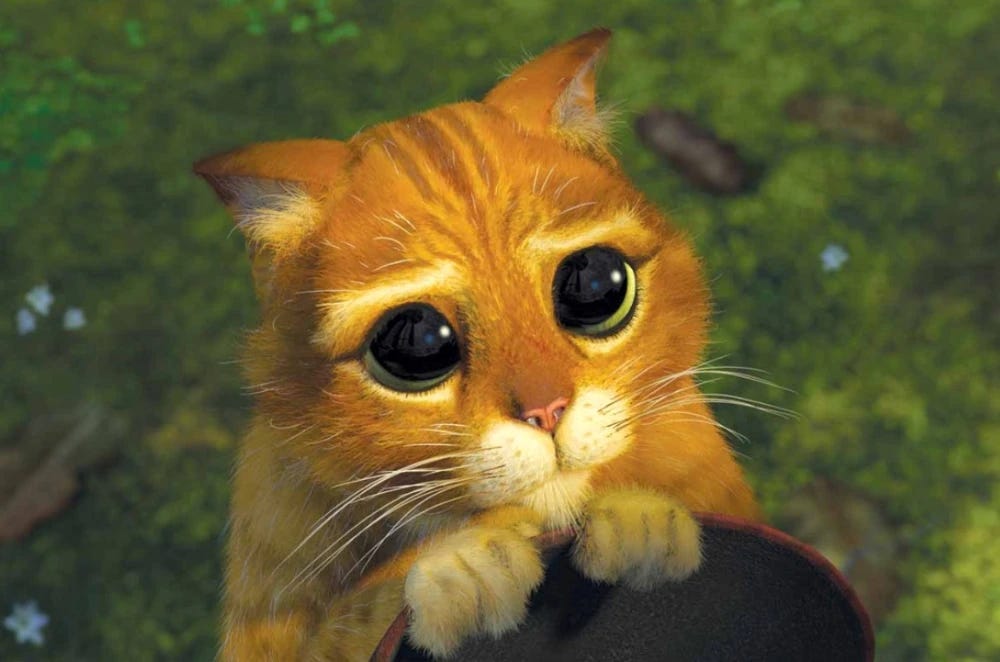The Truth About Puss in Boots (Shrek 2)
I'm sorry, the position of annoying, talking animal has already been taken
Once upon a time, people were actually excited about a Shrek sequel. In 2005, four years after the hit original movie, Shrek 2 introduced us to the breakout character Puss in Boots, a swashbuckling orange cat voiced by Antonio Banderas. Puss is an assassin who is hired by King John Cleese to kill Shrek for the crime of not being conventionally attractive. Puss almost immediately switches sides to join Shrek on his quest to not speak to his wife about their issues and instead base all his decisions on the diary she wrote when she was seven.
Puss in Boots inspired several spin-off movies, which I have not seen, as well as a TV show which I have also not seen. He is also in Shrek the Third and Shrek Ever After, both of which I did see but have blocked from my memory. When I rewatched this movie over Christmas I was fairly impressed with several aspects of Puss in Boots, including his bum wiggle before pouncing and his angry tail puff, but there were a few questions that I wanted to investigate more deeply.
Question 1: How many cats can wear boots?
This is such an important question that Shrek even asks it in the movie. And the answer is none. No cats should wear boots. They are uncomfortable and cats hate them. They restrict movement and inhibit normal behaviours such as climbing and scratching. While we’re at it, don’t put hats on your cats either. They don’t like it and they need their ears free to hear, communicate and ignore you.
Question 2: Do “cute eyes” exist?
Aside from his (weirdly undemonstrated) skill with a sword and the ability to cut glass with his claws, Puss’s main talent is something I have learned is called “cute eyes”. Many studies into why cats are so cute support the idea that their faces relate closely to “baby schema”. Baby schema was proposed by Konrad Lorenz, who thought that a large head, round face, large eyes and a small nose and mouth trigger a caregiving response in humans. Humans do appear to find cats more cute when they have shorter noses and other infant-like features, just like Puss.
Question 3: Are cats disloyal?
Puss remains loyal to the King for about one minute. Cats are generally not thought of as loyal creatures, since they are descended from solitary-living wild animals and so do enjoy their alone time. However, cats can and do live in social groups, including with people. Cats can form strong attachments with humans, for example when 70 cats were placed in an unfamiliar environment, 65% were more relaxed when their owner was with them.
As with human relationships, the connection between cats and humans (or ogres) depends on those involved. One study identified five different types of relationship between cats and their owners. Each type of relationship depends on several factors including the owner’s emotional investment in the cat as well as the cat’s acceptance of others and their “aloofness”. The study comes complete with a quiz and associated flow chart, which I of course had to take for the purposes of science.
The conclusion was that Shrek and Puss have a “friendship”1. This is reflected in Shrek being emotionally invested in Puss (“look at him in his wee little boots”) and Puss responding in kind (head rubbing, purring). At the same time, both are happy to be apart and relate well to others (although Shrek doesn’t really relate well to anyone). Conversely, The King and Puss had a “casual relationship”2 which explains why Puss wanders off and finds a new home, like a cat in a house with a new baby or a cat in a house with a new dog or a cat in a house where anything is weird and new (cats don’t like change).
Overall:
Don’t dress up cats.
The other types of cat-human relationships were ‘open relationship’, ‘remote association’, and ‘co-dependence’. Who knew science could involve fun quizzes?
Yes I ignored the fact cats don’t talk.
Shrek 2 Cat Accuracy Score = 6 out of 10 cats, (lost one point per boot, one for the hat and one for that weird cartwheel move, cats can’t do that)
References:
Hattori, M., Saito, A., Nagasawa, M., Kikusui, T., & Yamamoto, S. (2022). Changes in cat facial morphology are related to interaction with humans. Animals, 12(24), 3493.
Ines, M., Ricci-Bonot, C., & Mills, D. S. (2021). My cat and me—a study of cat owner perceptions of their bond and relationship. Animals, 11(6), 1601.
Little, A. C. (2012). Manipulation of infant‐like traits affects perceived cuteness of infant, adult and cat faces. Ethology, 118(8), 775-782.
Vitale, K. R., Behnke, A. C., & Udell, M. A. (2019). Attachment bonds between domestic cats and humans. Current Biology, 29(18), R864-R865.
Not sure this needed a quiz.
See footnote 1.







Very cool! At an anthrozoology conference last summer, I heard about another interesting recent study on attachment styles between cats and humans. Will look it up.